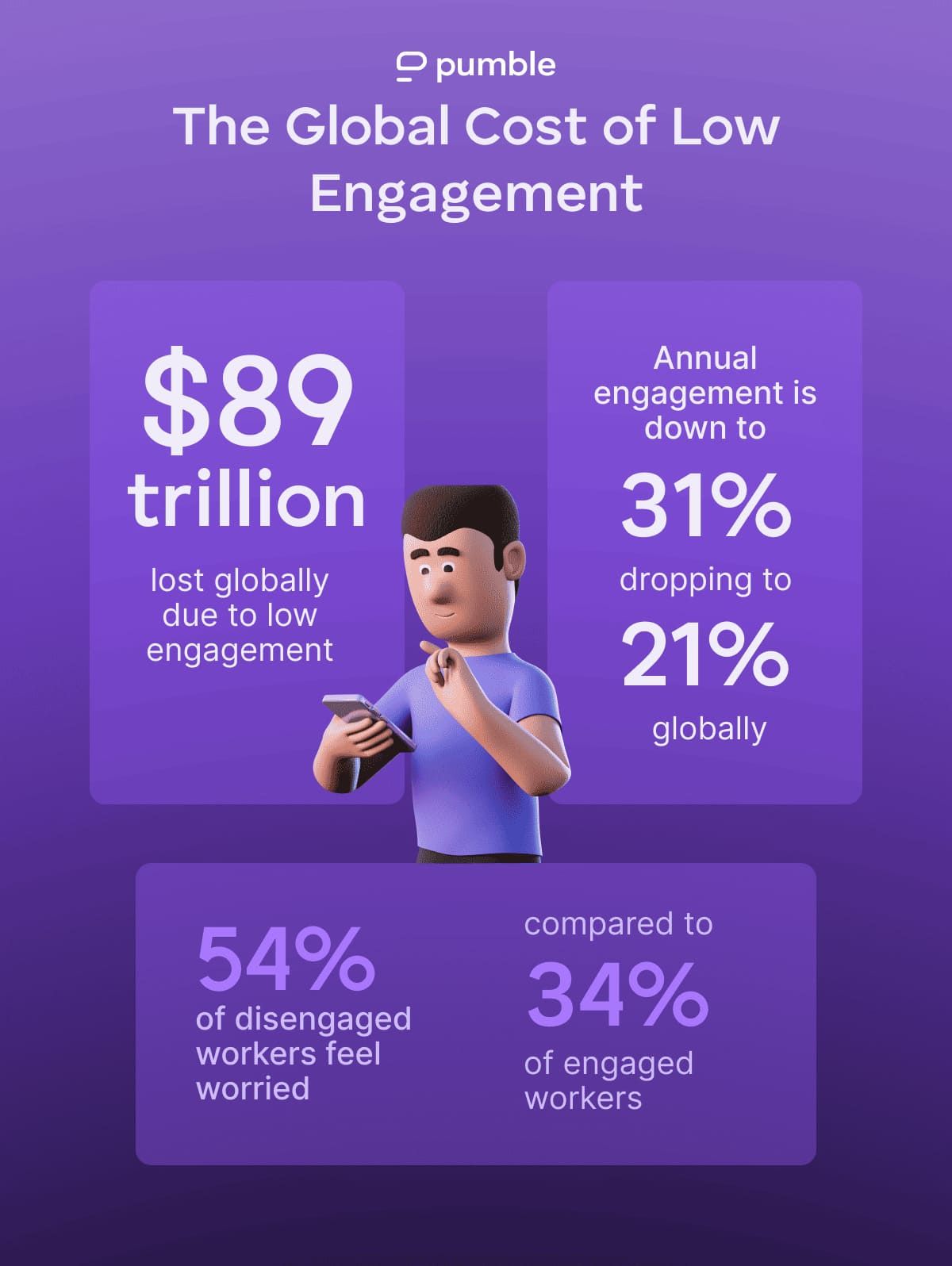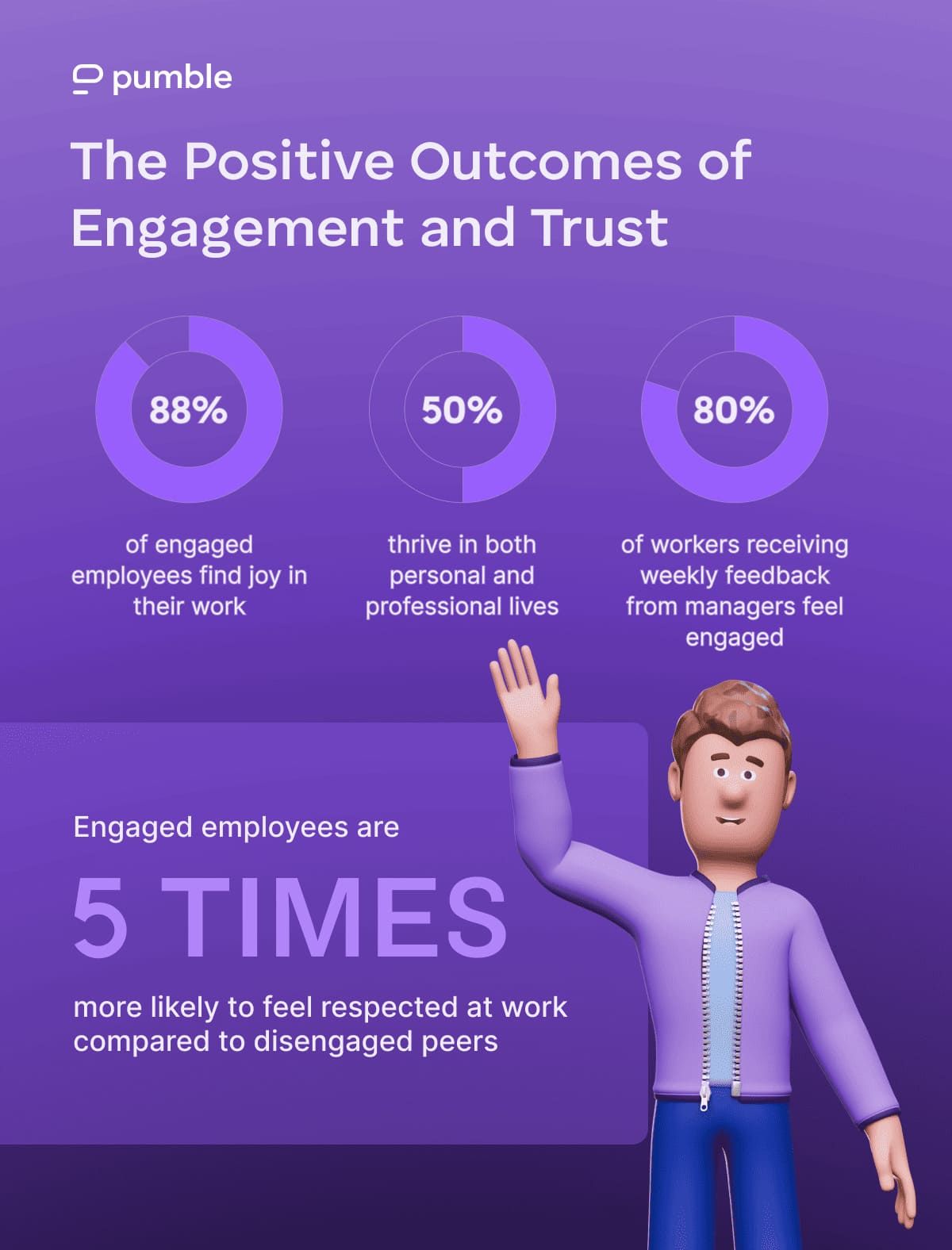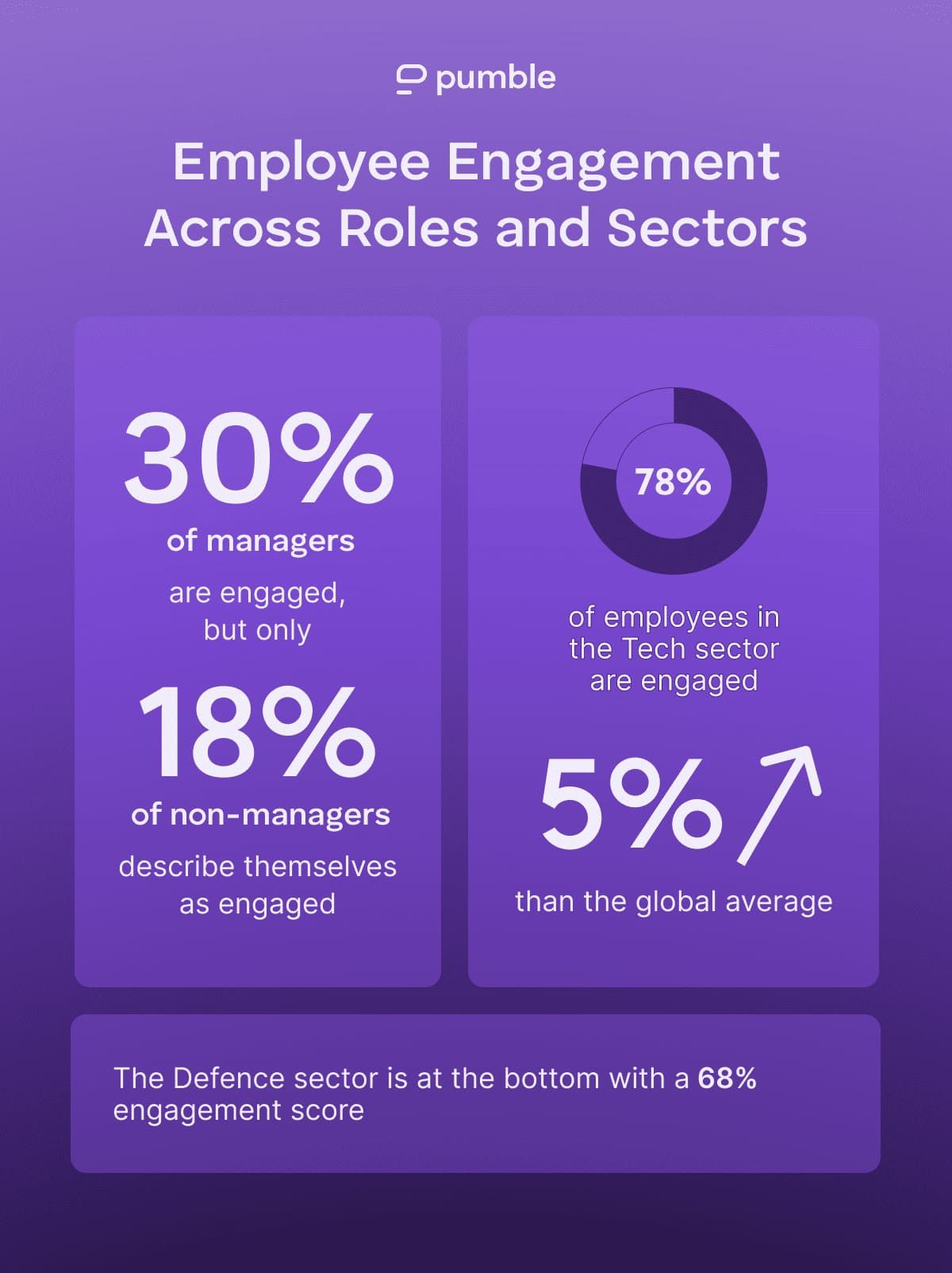As we spend about a third of our lives at work, it’d be nice to be satisfied and engaged during that time, right?
Unfortunately, employee engagement statistics aren’t so cheerful. In the US, annual engagement is down to 31%, dropping to a mere 21% globally.
But, is the big picture as bleak as the numbers suggest?
We bring you the most interesting figures on employee engagement, including the stats on:
- Emerging employee engagement trends,
- The cost of actively disengaged employees, and
- Factors that positively and negatively affect employee engagement.
Let’s dive in.

- Global losses amount to $89 trillion due to low employee engagement, with annual engagement levels dropping to 31% and further declining to 21% globally.
- Disengaged workers are more likely to experience worry, with 54% feeling this way, compared to only 34% of engaged employees.
- Engagement and trust have positive results. 88% of engaged employees enjoy their work, and 50% thrive in their personal and professional lives. Additionally, engaged employees are five times more likely to feel respected at work than their disengaged coworkers.
- 80% of workers who receive weekly feedback from their managers feel engaged.
- Only 30% of managers are engaged, while 18% of non-managers describe themselves as engaged.
- In the Tech sector, 78% of employees are engaged — 5% higher than the global average. The Defence sector has the lowest engagement score, at 68%.
What is employee engagement?
Employee engagement is a concept that describes the enthusiasm and commitment workers feel about their organization. The term also refers to employees’ emotions toward their company, which help them align their contributions with organizational goals.
In general, employees who are engaged in their roles find it easier to embrace company culture and deliver positive results.
When at its peak, workplace engagement has several upsides, including:
- Boosted productivity: You can work more efficiently and stay focused when you’re engaged.
- More innovation: If you feel connected to your team and the organizational vision, you’re more compelled to exchange solutions and ideas.
- Higher profits: Engagement is the driving force behind client satisfaction and productivity — both of which bring in revenue.
- Improved employee retention rates: In engaged teams, members are less likely to leave, keeping training and hiring costs at bay.
Of course, things aren’t always so clear-cut, and we recognize 3 levels of engagement:
- Engaged — employees who are emotionally committed to their jobs,
- Not engaged — employees who aren’t so enthusiastic about their jobs, but they do what they’re required, and
- Actively disengaged — unhappy employees who spread their negativity to others.
So, what happens when employees are not engaged or, worse yet, are actively disengaged? What are the consequences for their company?
Here’s what the latest employee engagement stats say.
After years of growth, employee engagement is stagnant
According to workplace data from Gallup, after years of improvement, employee engagement has stayed in place since 2023.
In 2024, US employee engagement trends showed that:
- 31% of workers were actively engaged, while
- 17% of workers were actively disengaged.
The State of Global Workforce report for 2024 notes that many employees face hurdles in their personal and professional lives, which hinder their productivity at work.
Still, employee engagement data from CultureAmp leaves room for hope. In 2023 and 2024, engagement levels sat at 71%, after peaking in 2020 and 2021 at 74%.
Why the slight dip? The last few years have been uncertain, from economic changes and AI implementation to international conflicts and the rise of flexible work.
These factors have put a damper on:
- The bottom line,
- Job satisfaction, and
- Employee wellbeing.
The cost of a disengaged workforce is steep
Low employee engagement has far-reaching consequences. Gallup estimates in its State of the Global Workforce report that it drains $89 trillion from the global economy annually — nearly a tenth of the worldwide GDP.
What’s more, The 2024 Engagement Report from People Element estimates that the turnover rate for disengaged teams is 43% higher than for engaged teams.
This data seems disheartening, but it doesn’t mean organizations should pinch pennies to make up for setbacks. On the contrary, it’s all the more reason to invest in long-term employee engagement strategies.
For instance, Harvard Business Review suggests that companies can drive engagement by:
- Allowing employees to explore different tasks and discover roles that align with their interests.
- Enhancing autonomy and empowering team members to make decisions independently.
- Establishing mentorship programs to boost skills and confidence.
Steps like these can positively impact organizational performance — and Google is one such success story. HBR highlights that the company’s peer buddy program showed that new hires working with a mentor were fully equipped to tackle their roles 25% faster than their peers who did not participate in the program.
Organizations can mitigate financial losses and address the emotional toll of low employee engagement by adopting similar strategies.

Disengaged employees experience higher levels of negative emotions
Gallup’s report dipped into employee experience and revealed another interesting fact — work affects our daily emotions and life experiences.
Actively disengaged employees go through high levels of worry, stress, and various other negative emotions, including:
- Sadness,
- Loneliness, and
- Anger.
Moreover, their negative feelings surpass those of their unemployed peers, pointing to the dangers of low engagement.
Here’s how they compare.
| Negative emotions | Actively engaged employees (%) | Non-engaged employees (%) | Actively disengaged employees (%) | Unemployed peers (%) |
|---|---|---|---|---|
| Stress | 34 | 40 | 54 | 42 |
| Worry | 30 | 36 | 52 | 52 |
| Anger | 17 | 19 | 32 | 28 |
| Loneliness | 17 | 19 | 31 | 32 |
| Sadness | 17 | 21 | 34 | 38 |
While stress overcomes 54% of actively disengaged workers, the figure drops to 34% for actively engaged teams.
Following this trend, engaged workers also experience higher levels of positive emotions. In fact, 88% of engaged employees report finding joy in their work, with 50% stating they thrive in their personal and professional lives.
On the flip side, actively disengaged workers report lower numbers than their unemployed counterparts regarding positive experiences.
The data speaks for itself.
| Engaged employees (%) | Non-engaged employees (%) | Actively disengaged employees (%) | Unemployed individuals (%) | |
|---|---|---|---|---|
| Enjoy | 88 | 80 | 57 | 67 |
| Thrive | 50 | 32 | 17 | 23 |
CultureAmp’s statistics on employee engagement align with these findings, noting a drop in workers’ sense of pride and motivation. In 2020, 88% of respondents reported feeling pride in their work, while 84% did so in 2024.
Similarly, motivation soared from 2020-2022 at 71% and reverted to 68% in 2024. These fluctuations coincide with return-to-office mandates and could be a response to the broken promises of more flexible work.
🎓 Pumble Pro Tip
Feeling unnerved by some of the numbers we’ve mentioned? There’s no reason to fret! The below blog post outlines several employee engagement strategies you can try, including a handy employee engagement survey template:
Managers are more likely to go through negative experiences than other employees
The State of the Global Workforce report found that managers can cause variations in employee engagement of up to 70%. Thus, they play an integral part in employee performance and well-being.
Overall, whereas 30% of managers are engaged, only 18% of non-managers would describe themselves in that way. This data matters since engaged managers are more likely to lead highly engaged teams.
However, managers are at a higher risk of experiencing negative emotions than their peers in non-managerial roles. Although they experience similar levels of stress, anger, and loneliness, the gap widens when it comes to sadness and worry.
| Experienced daily % | ||
|---|---|---|
| Emotion | Managers | Other employees |
| Stress | 41 | 40 |
| Worry | 39 | 36 |
| Sadness | 24 | 21 |
| Loneliness | 21 | 20 |
| Anger | 21 | 19 |
So, what’s the consequence of the stress and worry managers face? For one, they’re more prone to looking for a new job than employees in non-managerial positions.
This employee engagement data underscores that companies need to do more to appreciate and support managers — since they’re on the frontlines of supporting and empowering their teams.
In best-practice organizations, support for managerial staff may include:
- Using polls in team communication apps to determine what resources are most needed,
- Consistently recognizing contributions,
- Ongoing education and investment in professional development opportunities,
- Streamlined HR procedures, and
- Annual or biannual employee engagement surveys centered around specific topics (i.e., recognitions and rewards, employee well-being, team dynamics, etc.).

Stay in tune with your team in Pumble
When such measures are implemented, rewards soon follow. Best-practice organizations stand out with ¾ of managers and 7 in 10 non-managers actively engaged.
When managers are engaged, their teams are too
Gallup’s Q12 Meta-Analysis highlighted that only 3 in 10 managers feel engaged at work globally — a sad reality, given that the same report found that engaged managers also lead engaged teams.
Expanding its employee engagement survey to country-level, Gallup produced more specific data.
Namely, in countries where managers report a higher level of employee engagement, non-managers usually follow suit.
Here’s the comparison.
| Manager vs non-manager engagement % | ||
|---|---|---|
| Country | Managers | Non-managers |
| Lesotho | 49 | 44 |
| Costa Rica | 42 | 36 |
| United States of America | 37 | 32 |
| Argentina | 30 | 30 |
| Iceland | 27 | 23 |
| Canada | 22 | 20 |
| Germany | 17 | 12 |
| United Kingdom | 11 | 10 |
| France | 8 | 8 |
The above figures show that the divide between managers and non-managers isn’t as wide in places where managers are more engaged.
And, even in countries with low employee engagement, managers still score higher than other employees.
Feedback from managers makes a difference
Gallup’s report also found that 80% of workers who receive constructive feedback from managers at least once a week are engaged.
That means that instead of speedrunning your tasks, it’s better to take the time to speak with employees about their performance.

People Element’s findings are similar, showing that 1 in 3 employees feel underappreciated — something an annual feedback meeting will hardly fix.
However, feedback isn’t always welcome, as just 27% of employees would like to receive weekly feedback from management.
Weekly feedback makes us the most engaged, so why are we hesitant to adopt this practice?
The answer is simple — employees don’t want to waste their time if the feedback isn’t efficient.
When appropriately given, critical feedback:
- Eliminates misunderstandings and
- Outlines steps for future growth and development.
Thus, to make sure it has a positive effect on employee performance and engagement, managers should:
- Regularly host 1-on-1 and group meetings with their team members,
- Avoid harsh language,
- Foster a psychologically safe environment so that employees can speak up, and
- Repeat and clarify long-term goals.

🎓 Pumble Pro Tip
Making the most of feedback is an ongoing process. Here are some resources that can help your team reap the benefits of constructive feedback:
Make every conversation count with Pumble
Unclear career paths reduce employee engagement
People Element underscores the opportunity for growth as a main component of employee engagement — 83% of employees said that professional development is what they value most in a job.
Additional figures support this sentiment as:
- 65% of employees feel they have sufficient opportunities for professional development and
- 1 in 3 employees believe they have no one to support their workplace development .
As economic and technological circumstances continue to evolve, organizations will have to create initiatives to reskill their workforce and reshape jobs.
This might entail prioritizing internal talent mobility, which encourages career advancement within the organization. Employees may even want to transition from their current position to a new one where they’d have to start fresh. For this to succeed, it’s necessary to cultivate a culture of continuous learning.
Setting clear goals is a major engagement issue
Deloitte’s analysis of employee engagement strategies identified goal setting as a hurdle for most organizations. Namely, just 51% of businesses try to develop aligned goals, while a meager 6% attempt to revisit them later on.
When employees see that goals are openly shared and well-articulated, they feel more comfortable among team members, which spurs creativity and productivity.
Moreover, teams that are aligned with company goals experience a higher level of job satisfaction. Naturally, these benefits only occur if the goals are frequently revisited and re-defined.
🎓 Pumble Pro Tip
Aligning your team with company goals takes some effort. This 3-step guide can help you start:
Achieve your collaboration goals with Pumble
The Technology sector leads the charge with engaged employees
The Global Workplace Report for 2024 from WorkL found differences in employee engagement across industries.
The good news is that in 2024, most industries saw an increase in employee engagement compared to 2023, hitting or even exceeding the report’s 70% benchmark.
The Technology sector secured the top position with 78% — 5% higher than the global average. Additionally, this sector boasts a low well-being risk score of only 18%, which could stem from more supportive policies and a positive workplace culture.
Employees working for tech companies report a high sense of pride in their work, scoring 77%, meaning that they find their jobs fulfilling and worthwhile.
The Retail and Defense sectors have the most disengaged employees
Some industries, like the Defense and Retail sectors, failed to reach the 70% engagement benchmark.
The Defence sector is at the bottom, with an employee engagement score of 68%. Given how turbulent the past few years have been — with the escalation of several global conflicts — this is unsurprising.
The situation in the Retail sector is hardly better – its engagement score falling to 69%. Low employee engagement in this sector is rampant in New Zealand, the United Kingdom, and Canada.
Employees are particularly unhappy with:
- Understaffing,
- Disrespectful management,
- Insufficient compensation, and
- Working hours.

The gender and disability gaps persist
WorkL’s employee engagement data further pinpointed a slight difference between men and women. The greatest imbalance is in the US, where the engagement score is 73% for women and 77% for men.
Additionally, women are more likely to leave their jobs, with a Flight Risk score of 25%. For men, the score goes down to 20%.
But, the disability gap is most pronounced in the UK. Disabled workers have an employee engagement score of 68% — the lowest rating globally. They report that one of the major contributors to their disgruntlement is insufficient disability awareness in the work environment.
Moreover, their dissatisfaction deepens when we link employee engagement to pay satisfaction. When focusing on pay, the engagement rate for people with disabilities drops to 63%, while it’s slightly higher for other workers, at 66%.
As salary still has a noticeable impact on employee engagement, it has led to the rise of the “engagement and pay satisfaction gap.”
Compensation remains a key improvement point
Employee engagement research from WorkL revealed that globally, employees would like to work fewer hours with better compensation.
The number of employees seeking flexible work — either hybrid or fully remote — has doubled from 2019 to 2024. And, 24% of employees who’d like more flexibility also mention wanting a higher salary.
What happens when employees feel they are paid fairly? Their engagement score improves significantly.
Let’s look at the chart.
| Country | Employee engagement (%) among people who believe they’re paid fairly |
|---|---|
| Philippines | 79 |
| United Arab Emirates | 74 |
| United States of America | 71 |
| Global | 70 |
| Canada | 69 |
| Australia | 69 |
| United Kingdom | 68 |
A bigger paycheck alone won’t guarantee more engaged employees. What teams actually require is ongoing support that makes their time on the clock worthwhile.
Confidence in leadership continues to drive employee engagement
The 2024 Engagement Report also notes that confidence and trust in leadership are waning, with only:
- 23% of employees saying they firmly trust their leadership,
- 2 in 3 employees believing leadership communicates a clear vision for the future, and
- 63% of employees feeling they receive sufficient communication from leadership.
In organizations where employees have confidence in their leaders, engagement takes an upward trajectory, reports CultureAmp.
Yet, only 37% of businesses asked their workforce for feedback on confidence in leadership in 2024, compared to 54% in 2019. This decline could indicate a negative trend, where companies skip this question deliberately to avoid unwanted responses or may be unwilling to allocate resources to address the issue.
According to CultureAmp, these are the most prominent global drivers of employee engagement, particularly about confidence in leadership.
| Drivers of employee engagement — Confidence in leadership |
|---|
| “I am confident in our leaders.” |
| “The company provides an excellent workplace culture for me to further grow and develop.” |
| “Leadership has shared a vision that empowers and motivates me.” |
| “Leadership has shown that people are instrumental in organizational success.” |
The above drivers suggest that, besides a positive environment and fair compensation, employees expect guidance and clarity to succeed in their roles.
A proven approach is to foster transparent communication and practice active listening. This creates opportunities for leaders to build genuine, honest connections with employees.
Connect with your team in Pumble
Respect at work reaches a new low
Gallup’s data on respect at work shows that 4 in every 10 workers in the US feels they are treated with respect on the job. And, only 37% of employees agreed that they were treated respectfully at work in 2024, the lowest figure since 2022.
Why does this matter? Firstly, employee engagement and respect go hand in hand.
Engaged employees feel empowered and respected because their team:
- Appreciates new insights,
- Celebrates their success, and
- Cares about everyone’s professional development.
In such an environment, it’s no wonder employees feel they’re treated fairly and respectfully. In fact, engaged employees are 5 times more likely to report feeling respected in the workplace than their disengaged peers.
Local job markets affect employee engagement
The state of your local job market is another factor that impacts your work engagement. Namely, when there are fewer job opportunities, disengagement levels rise. Alternatively, when the job market improves, so does the employee engagement rate. This makes sense, since it’s natural to feel unhappy when you can’t find a better job.
Let’s look at some country-specific data from the State of the Global Workplace report.
| Country | “It’s a good time to search for a new job” (%) | Actively disengaged employees (%) |
|---|---|---|
| Denmark | 80 | 7 |
| Iceland | 79 | 7 |
| Australia | 74 | 12 |
| Germany | 67 | 17 |
| United States of America | 65 | 16 |
| France | 44 | 18 |
| Japan | 40 | 24 |
| Italy | 32 | 25 |
| Tunisia | 11 | 42 |
Note that an uptake in employee engagement doesn’t occur automatically when economic conditions improve. For this to happen, other changes are necessary, such as increased support from leadership and management.
Act now & create a highly engaged workforce with Pumble
Given the employee engagement statistics we discussed, it’s likely that only about a quarter of your workforce is actively engaged. Without immediate action, you risk losing both revenue and top talent.
Start with addressing challenges as soon as they arise.
Apps like Pumble streamline workplace communication, with real-time direct messages and threaded conversations allowing everyone to have transparent discussions and address concerns.
Keep ongoing dialogue alive with video conferencing features and connect with team members in a human and empathetic way.

Leverage Pumble’s full scope of communication and collaboration features and make sure employee engagement never becomes a roadblock.
Keep your team connected, no matter where they work.
How we reviewed this post: Our writers & editors monitor the posts and update them when new information becomes available, to keep them fresh and relevant.
